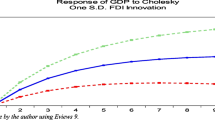Abstract
Recent evidence suggests that regional economic integration provides an important stimulus not only to trade, but also to FDI. In contrast, the available theory on FDI does not yet provide empirically testable propositions on the effects of concurrent trade and investment liberalisation. Moreover, given the limits of simulation models, which rely heavily upon parameter choice, in assessing the impact of such liberalisation, there is a need for empirical analysis to identify the principal features of FDI. This paper uses a ‘gravity model’ approach to assess the impact of the deepening integration between the EU and the CEECs on FDI flows in terms of three key issues. First, we provide systematic estimates of the expected long-term level of FDI in the CEECs. Second, we investigate whether FDI in the CEECs, on the one hand, and source country exports and imports, on the other hand, are complements or substitutes. Finally, we enquire whether an increase in the attractiveness of the CEECs to foreign investors has affected the magnitude of FDI going to other European countries.
Similar content being viewed by others
References
Baldwin, R.E., Forslid, R. and Haaland, J. (1995) ‘Investment Creation and Investment Diversion: Simulation Analysis of the Single Market Programme’, Discussion Paper 1308, CEPR, London.
Brainard, S.L. (1997) ‘An Empirical Assessment of the Proximity-Concentration Trade-off Between Multinational Sales and Trade’, American Economic Review 87(4).
Brenton, P. and Di Mauro, F. (1998) ‘The Potential Magnitude and Impact of FDI flows to CEECs’, CEPS Working Document n. 116, February.
Brenton, P. and Gros, D. (1997) ‘Trade Reorientation and Recovery in Transition Economies’, Oxford Review of Economic Policy 13(2), 65–76.
Brenton, P. (1996) ‘The Impact of the Single Market on Foreign Direct Investment in the EU’, Report for DGII, European Commission.
Eaton, J. and Tamura, A. (1996) ‘Japanese and US Exports and Investment as Conduits of Growth’, NBER Working Paper 5457.
Graham, E.M. (1996) ‘On the Relationship Among Foreign Direct Investment and International Trade in the Manufacturing Sector: Empirical results for the United States and Japan’, WTO Staff Working Paper RD–96–008.
Johnson, B.T., Holmes, K.R. and Kirkpatrick, M. (1998) ‘1998 Index of Economic Freedom’, The Heritage Foundation, The Wall Street Journal.
Linnemann, H. (1966) ‘An Econometric Study of International Trade Flows’, Amsterdam: North-Holland.
Lankes, H.-P. and Venables, A.J. (1996) ‘Foreign Direct Investment in Economic Transition: The Changing Pattern of Investments’, Economics of Transition, 4(2), 331–347.
Markusen, J.R. (1997) ‘Trade Versus Investment Liberalisation’, Nota di Lavoro 75.97, FEEM, September.
Markusen, J.R. and Venables, A.J. (1996) ‘The Theory of Endowment, Intra-Industry and Multinational Trade’, CEPR Discussion Paper N. 1341, February.
Markusen, J.R. and Venables, A.J. (1995) ‘Multinational Firms and the New Trade Theory’, NBER Working Paper 5036.
Markusen, J.R., Venables, A.J., Konan, D.E. and Zhang, K.H. (1996) ‘A Unified Treatment of Horizontal Direct Investment, Vertical Direct Investment, and the Pattern of Trade in Goods and Services’, NBER Working Paper 5696, Cambridge MA, August.
Mátyás L. (1997) ‘Proper Econometric Specification of the Gravity Model’, The World Economy, 20, 363–368.
Polak, J.J. (1996) ‘Is APEC a Natural Regional Trading Bloc? A Critique of the ‘Gravity Model of International Trade’’, The World Economy 19(5), 533–43.
Piazolo, D. (1997) ‘Trade Integration between Eastern and Western Europe: Policies Follow the Market’, Journal of Economic Integration 12(3), September, 259–297.
Sapir, A. (1997) ‘Domino Effects in Western European Trade, 1960–92’, CEPR Discussion Papers N. 1576, February.
Sinn, H.W. and Weichenrieder, A.J. (1997) ‘Foreign Direct Investment, Political Resentment and the Privatization Process in Eastern Europe’, Economic Policy 24, 179–210.
Szalavetz, A. and Lücke, M. (1997) ‘Export Reorientation and Transfer of Know-how and Technology — The case of Hungarian Manufactured Exports’, Kiel Working Papers, No. 801, Kiel Institute of World Economics, March. Forthcoming in Conference Volume.
Winters, L.A. (1997) ‘Assessing Regional Integration Arrangements’, mimeo, World Bank, Washington D.C.
Author information
Authors and Affiliations
Rights and permissions
About this article
Cite this article
Brenton, P., Di Mauro, F. & Lücke, M. Economic Integration and FDI: An Empirical Analysis of Foreign Investment in the EU and in Central and Eastern Europe. Empirica 26, 95–121 (1999). https://doi.org/10.1023/A:1007006429600
Issue Date:
DOI: https://doi.org/10.1023/A:1007006429600




